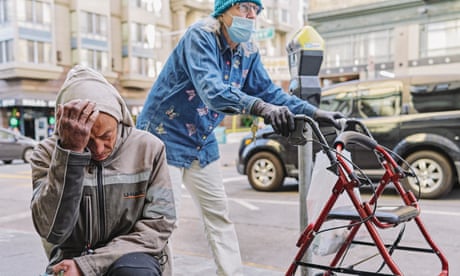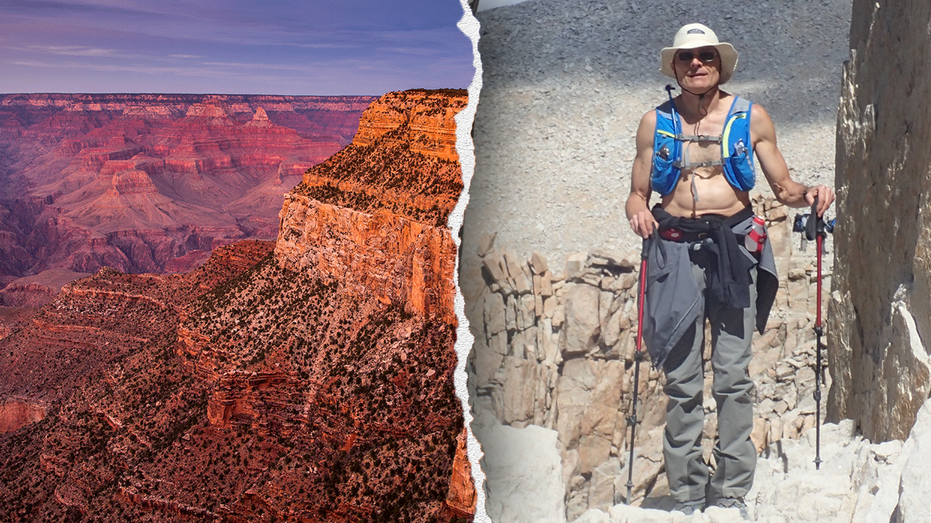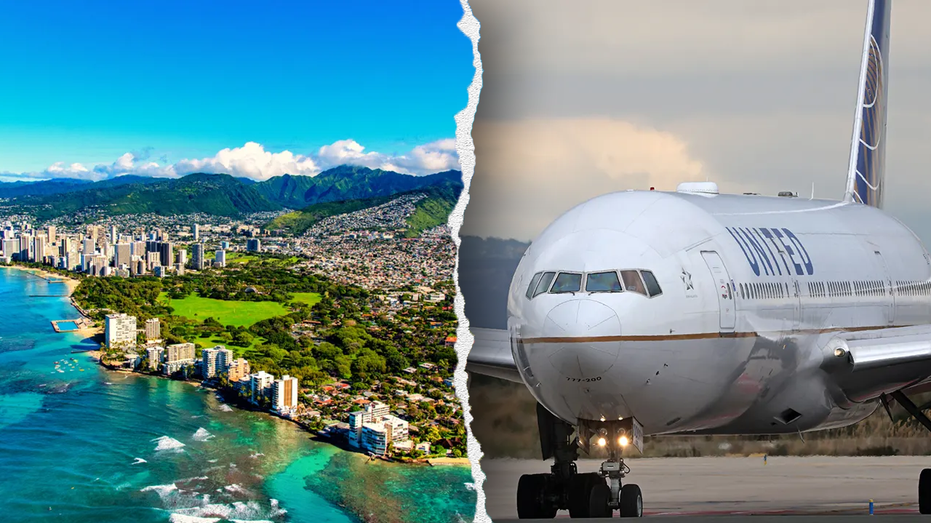- by foxnews
- 23 May 2025
The daily battle to keep people alive as fentanyl ravages San Francisco’s Tenderloin
The daily battle to keep people alive as fentanyl ravages San Francisco’s Tenderloin
- by theguardian
- 24 Apr 2022
- in news

It's 9am in San Francisco's Tenderloin district and sleeping bodies line the sidewalks as Felanie Castro sets out on her route in Glide Foundation's harm reduction van.
Along Ellis Street, hungry people queue up for the Glide's daily breakfast of buns, hard-boiled eggs and plastic-wrapped muffins. Down the block, a fire department truck, part of a city response team, awaits the day's first drug overdose call.
This neighborhood and the adjoining South of Market (SoMa) district have become ground zero in an opioid overdose crisis that is killing thousands of California residents, including many experiencing homelessness. In the past two years, more than 1,300 people have died of overdoses in San Francisco, a rise driven by the emergence of fentanyl, a super-potent synthetic opioid that's 50 times stronger than heroin. Nearly half of those deaths have occurred in these two hard-hit neighborhoods alone.
Castro and Glide's harm reduction team are fighting one front in the battle to keep people alive.
Glide Foundation, the parent organization of San Francisco's Glide Memorial Church, has been advocating for the rights of the poor and disenfranchised communities since the 1960s. Today Glide runs dozens of programs, including support for those struggling with homelessness and addiction. Armed with supplies such as clean syringes, glass pipes, alcohol wipes and bottles of water, their team aims to give people the health tools to make drug use as safe as possible, while working to build the trust that drug users may need to eventually seek help.
Among the most powerful tools in their arsenal are nasal spray bottles of Narcan, each containing 4mg of the life-saving opioid-reversal drug naloxone. Castro says she has already reversed 50 overdoses using Narcan, in the Tenderloin and around the city.
But she can't save everyone alone. As part of a broader harm reduction strategy, providers are offering Narcan at clinics, meal programs and homeless drop-in centers and distributing it directly into the hands of drug users and anyone living around them, increasing the chances someone can act.
"The idea is to have Narcan available everywhere," said Laura Guzman, a senior director at the National Harm Reduction Coalition.
As the Glide outreach van pulls up to a collection of tarps and tents under the shadows of a freeway overpass that morning, Castro and her partner, Rizzy Spoer, call out to the occupants, who appear to be sleeping inside.
"Hi, sorry to bother you. We're from Glide. We have harm reduction supplies and basic needs stuff. Do you need anything?"
A bearded young man in a baseball cap comes out and asks if he can have some "longs" and some "shorts", referring to two different sizes of syringes.
Castro loads a paper bag with the supplies and offers some water. Then she calls to the soft-spoken young man as he turns to go back to the tent: "And also, do you have any Narcan in there?" The man gratefully takes a single-dose Narcan dispenser wrapped in foil packaging.
The Tenderloin, a historic neighborhood in the heart of San Francisco's downtown, comprises roughly 50 square blocks, most built just after the 1906 earthquake. During the 20th century its gently sloping streets and residential hotels developed a reputation as the city's seedy underbelly, known for drug dealing, sex work and vice.
Today the Tenderloin is grappling with the interlocking crises of homelessness, poverty and addiction. It's home to hundreds of people trying to survive without housing, many living just steps from glitzy high-rise apartments, luxury brand shops, and the headquarters of tech companies such as Twitter and Uber.
The city supervisor Matt Haney, who represents and lives in the district, describes it as a place of last resort for people who have fallen through the social safety net.
"The Tenderloin is a place where people who have been pushed out, stepped on and who are struggling can find a home and refuge," he said. "That's a powerful and beautiful thing. It also brings with it a lot of need."
In recent years, new forces have intensified those challenges. One is the rise of fentanyl, now the substance of choice for many illicit drug users in San Francisco. Another is soaring rents and a statewide housing crisis that experts say has pushed even more people on to the streets.
Resolving the situation has become one of the city's most divisive issues. Facing mounting pressure to act, San Francisco's mayor, London Breed, declared a "state of emergency" in the Tenderloin in December 2021 - promising a crackdown on drug dealers, more interventions for users and cleaner streets.
The declaration reignited a debate at the heart of drug addiction treatment: should users be given "tough love" and urged to abstain from drug use? Or should the city make drug use safer and help people rebuild their lives at their own pace?
Opinions range, with some in favor of the abstinence-based approach, a philosophy often associated with America's "war on drugs" era, and some who want the city to use a firmer hand to clear the Tenderloin of visible drug use and encampments.
In contrast, harm reduction advocates say widely accepted scientific evidence shows this strategy is ineffective at reducing addiction in the long term. In addition to placing people in supportive housing, they believe the city should open supervised spaces for people to use drugs, so they can receive prompt medical attention in the case of an overdose. Slowly building relationships, they say, helps people get into treatment and ultimately heal.
"Harm reduction is sort of the flip side of criminalizing drug use," said Glide Foundation's CEO, Karen Hanrahan. "We practice harm reduction to save lives and to reduce disease, but also because it builds relationships with people who we can then wrap our arms around and help them through a continuum of other services that they need."
Harm reduction started as an underground movement distributing clean needles to drug users during the Aids epidemic of the 1980s, said Dr Daniel Ciccarone, a professor specializing in addiction medicine at the University of California, San Francisco. The mantra, at a time "when injection drug users and men who had sex with men were not only ignored, but were vilified", says Ciccarone, "was meeting people where they're at - not judging them, not disciplining them, not telling them what they needed to do."
Those principles now form much of what we think of as drug treatment, he said, from the use of medicines like methadone and buprenorphine to help wean people from opioids, to the counseling that helps people rebuild their sense of dignity. And for the first time, harm reduction became part of federal policy when the Biden administration included it as a pillar of its plan to stem national overdose deaths.
"It started scrappy; it started low-budget and it started underground," said Ciccarone, who worked with street activists in the 1980s trying to stop the spread of Aids. "It has grown to become legitimate, accepted, funded and politically approved."
Proponents of harm reduction are putting their methods up against one of the greatest tests yet as fentanyl floods the US drug market.
In California, the number of fatalities attributed to fentanyl jumped by more than 2,100% in five years. In San Francisco, overdose deaths hit a new high of 711 during the first year of the pandemic, with those experiencing homelessness facing some of the highest mortality rates.
According to Alex Kral, who has been interviewing opioid users for decades as part of his work with the non-profit research institute RTI International, many heroin users have switched over to fentanyl - which is being both injected and smoked - because it's a cheaper and quicker high. But the drug's extreme potency means that even longtime opioid users can quickly go into a breath-stopping overdose.
That's made distributing Narcan even more urgent. While there's no silver bullet for the crisis, experts say many more would be dying without it.
For example, in 2021, after climbing precipitously for three years, the number of overdose deaths in the city decreased slightly to 650, a period that coincided with Narcan resuscitations ramping up significantly - from 4,300 in 2020 to 8,200 in 2021.
Several months ago, Laurie Rudner, a former Tenderloin resident, saw for herself just how fast fentanyl can take someone out.
A friend was sitting in front of her in a wheelchair when he took a hit of the drug. Almost instantly, she saw the drink he was holding drop out of his hand. Fortunately, Rudner had been given some Narcan. She pulled it out of her bag, and she and another friend rushed to their fallen companion and squirted the Narcan up his nose.
An ambulance arrived quickly and administered several more doses of the antidote and, pretty soon, Rudner's friend was breathing again and on his way to the hospital.
"The main problem right now is fentanyl," said Rudner. "There have been like two deaths a day."
While the drug is killing everyone from Hollywood celebrities to high school teenagers, it has posed a particular threat to people experiencing homelessness, driving a doubling of deaths among this group during the first year of the Covid-19 pandemic, according to a UCSF study.
One big difference between the late 1990s and now, said Kral, is that back then only about 30% of all injection drug users surveyed considered themselves homeless. Today, the figure is 75% to 80%.
He believes the difference is that much of the cheap, marginal housing - like $20-a-night hotels, warehouse spaces and abandoned buildings - has disappeared and been replaced by high-rise condominium buildings fetching top dollar from tech industry employees.
"People no longer have places to be," he said.
Reginald Dillard Sr, 65, says what he sees happening on the streets now terrifies him. Born in San Francisco, he has lived in the Bay Area his whole life. After his family lost their West Oakland home in the 2008 housing crash, Dillard said, "I did a few too many drugs and I ended up on the sidewalk."
Dillard spent years living on the streets in the Tenderloin before he got help from a city caseworker and, four years ago, moved into a subsidized one-room apartment in an old Tenderloin hotel. Now he surveys the street scene around Glide from a distance, looking sharp in a white and blue windbreaker, jeans and a baseball cap.
"I'm scared to death of fentanyl," he said. "It don't take but a match head's worth of that stuff to put you out for good."
Twenty-nine-year-old Eletise Niumata has experienced those dangers first hand. Sitting in a wheelchair a few blocks from Glide, she places pink fentanyl powder on a square of tin foil and holds a lighter underneath, inhaling the rising fumes through a straw-like tube.
Between puffs, Niumata explains that her name means "electricity" in her ancestral homeland of Samoa, a place she visited twice while growing up in San Francisco. In recent years, both she and her younger sister have faced homelessness. She's been trying to get into housing, but hasn't managed to yet.
Niumata says she's overdosed and been revived by naloxone two or three times. With Narcan, "everybody can help out. If you need some, probably somebody has it."
Recently, the city opened a "linkage center" in the Tenderloin, providing a place for those without housing to get respite and hook up with services such as treatment and housing referrals. The center offers hot meals, restrooms and showers - and people are allowed to use drugs in a fenced outdoor area, a decision that not everyone agrees with.
Since the linkage center opened in January, 35 drug overdoses have been caught and reversed with Narcan, according to a statement from the city's health department.
Finding housing for people who visit the center has been a much slower process. The city's website shows that as of 10 April, the linkage center has received 28,984 visits and provided 1,220 referrals to services, yet the city's housing data for the project show only 99 people have gotten housing, with another 71 placed on a priority list. The linkage center made an additional 366 placements into temporary shelter beds.
In Glide's outreach van, Felanie Castro is trying to make a difference one visit a time.
The van comes equipped to provide testing for Covid-19, HIV, hepatitis C and a variety of sexually transmitted diseases. The team also passes out lots of bottled water, feminine supplies, snacks, and self-heating meal kits, in varieties like "rotini and kielbasa sausage in a spicy sauce".
Smoking supplies, including tin foil, straws and glass pipes, are increasingly in demand. Distributing the materials has raised controversy at the federal level - after conservatives erroneously charged that federal money was going to be used to pass out "crack pipes".
But no federal funding goes to glass pipes, and Castro dismisses criticism that her work encourages drug use. "We're not just here to give out stuff," she said. "Everything we do out here is public health. We want to lower the barriers to getting help. That's my job: lowering the barriers to physical health or mental health."
Once a week, a doctor from the city of San Francisco's street medicine team rides along in the harm reduction van and offers medical services to anyone who wants them. The mobile doctors are even able to start people on drug-assisted treatment, a method favored by harm reduction specialists, that can help them get off opioids without the excruciating withdrawal symptoms.
Frank Vaccari, who now lives in a residence hotel in the Tenderloin, credits the earliest form of medication-assisted treatment available in the United States, methadone, with getting him off heroin and off the streets more than two decades ago.
"I couldn't get off cold turkey," he said "When I tried, it was horrible. You couldn't eat. You couldn't sleep. You're throwing up. Your eyes are ready to pop out of your skull. The physical effects go on for weeks. Then there's the mental effects."
Vaccari, 63, goes to the methadone clinic three days a week to pick up his treatment, which comes in the form of a pink syrup, which he said "tastes nasty, but works real good" to stave off withdrawals.
Many other people he knows have died of overdoses. In January, Vaccari found his younger brother dead of a fentanyl overdose in his own apartment.
As Vaccari steps out on to the Tenderloin's Eddy Street in his purple pajama pants to give his chihuahua, Cleo, a quick walk, he credits the harm reduction philosophy for keeping him alive.
"Methadone saved my life," Vaccari said. "I would have been dead years ago."
- by foxnews
- descember 09, 2016
United Airlines flight returns to Hawaii after concerning message found on bathroom mirror; FBI investigating
United Airlines Flight 1169 to Los Angeles returned to Hawaii after a "potential security concern" aboard the plane. The FBI and police are investigating.
read more


